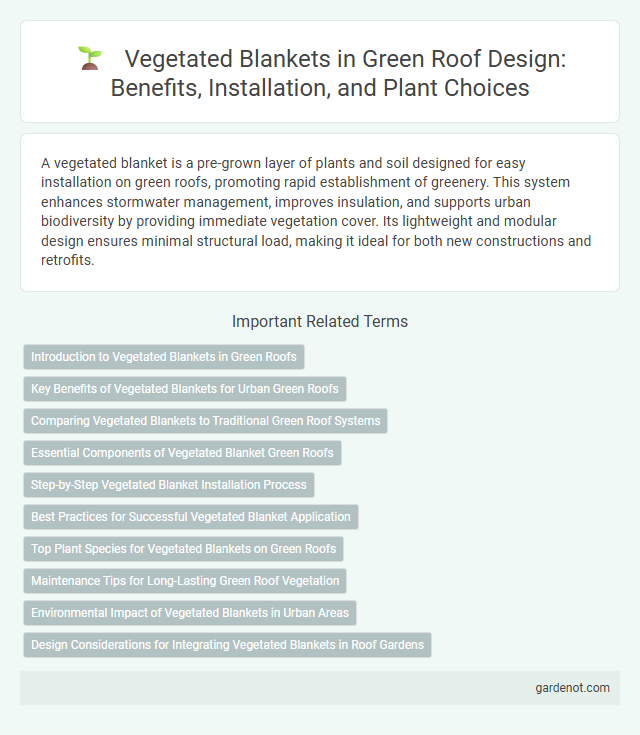A vegetated blanket is a pre-grown layer of plants and soil designed for easy installation on green roofs, promoting rapid establishment of greenery. This system enhances stormwater management, improves insulation, and supports urban biodiversity by providing immediate vegetation cover. Its lightweight and modular design ensures minimal structural load, making it ideal for both new constructions and retrofits.
Introduction to Vegetated Blankets in Green Roofs
Vegetated blankets are pre-grown layers of plants and growing medium designed for quick installation on green roofs, providing immediate vegetative cover and erosion control. These modular systems contain drought-tolerant species that thrive in shallow substrates, promoting biodiversity and reducing roof surface temperatures. Their lightweight composition optimizes structural load capacity while supporting stormwater management and enhancing urban air quality.
Key Benefits of Vegetated Blankets for Urban Green Roofs
Vegetated blankets significantly enhance urban green roofs by providing immediate ground cover that reduces soil erosion and supports plant establishment. These pre-grown mats improve stormwater management by increasing water retention and delaying runoff, which helps mitigate urban flooding. Furthermore, vegetated blankets contribute to urban heat island reduction through improved insulation and evapotranspiration, promoting cooler building surfaces and surrounding environments.
Comparing Vegetated Blankets to Traditional Green Roof Systems
Vegetated blankets provide a lightweight, pre-grown alternative to traditional green roof systems, offering faster installation and immediate vegetation coverage. These blankets typically combine sedum or drought-resistant plants in a thin growing medium, reducing substrate depth compared to conventional green roofs that require deeper soil layers for diverse plantings. The reduced weight and quicker establishment make vegetated blankets ideal for retrofit projects or structures with load limitations, whereas traditional systems provide greater biodiversity and stormwater retention benefits.
Essential Components of Vegetated Blanket Green Roofs
Vegetated blanket green roofs consist of essential components including a waterproof membrane, root barrier, drainage layer, filter fabric, and a pre-vegetated mat or blanket that incorporates a growing medium with drought-tolerant plants. These components work together to provide water retention, root protection, and structural support while promoting plant growth and thermal insulation. The integrated system reduces stormwater runoff, enhances building energy efficiency, and supports urban biodiversity.
Step-by-Step Vegetated Blanket Installation Process
The vegetated blanket installation process begins with thorough roof surface preparation, including cleaning debris and verifying waterproofing integrity. Next, a compatible drainage layer is laid, followed by the uniform placement of the vegetated blanket, ensuring proper alignment and coverage. Final steps involve securing the blanket edges and hydrating the vegetation to promote root establishment and optimal growth.
Best Practices for Successful Vegetated Blanket Application
Optimal vegetated blanket application relies on selecting appropriate plant species with robust root systems suited to local climate and soil conditions. Ensuring proper substrate depth and quality enhances water retention and nutrient availability, critical for plant establishment and growth. Regular maintenance, including irrigation during dry periods and monitoring for pest infestation, supports long-term vegetation health and green roof performance.
Top Plant Species for Vegetated Blankets on Green Roofs
Sedum species dominate as the top plant choice for vegetated blankets on green roofs due to their drought tolerance and shallow root systems. Other popular species include Sempervivum, Delosperma, and low-growing native grasses that enhance biodiversity and improve microclimate regulation. These plants optimize stormwater retention, reduce urban heat island effects, and require minimal maintenance, making them ideal for green roof installations.
Maintenance Tips for Long-Lasting Green Roof Vegetation
Vegetated blankets require consistent watering schedules to ensure deep root hydration and prevent drought stress, critical for sustained green roof health. Regular inspection for pest infestations and removal of invasive weeds maintains optimal plant growth and prevents vegetation damage. Seasonal fertilization using slow-release, balanced nutrients supports vigorous growth and enhances the roof's ecological benefits over time.
Environmental Impact of Vegetated Blankets in Urban Areas
Vegetated blankets significantly improve urban air quality by absorbing pollutants and carbon dioxide, contributing to the reduction of the urban heat island effect. These green installations enhance stormwater management by increasing water infiltration and reducing surface runoff, thus mitigating flood risks in densely built environments. Furthermore, vegetated blankets provide essential habitats for urban biodiversity, supporting pollinators and other wildlife critical for ecosystem balance.
Design Considerations for Integrating Vegetated Blankets in Roof Gardens
Vegetated blankets for roof gardens require careful design considerations including appropriate substrate depth, plant selection, and irrigation requirements to ensure optimal growth and sustainability. The lightweight structure mandates materials that balance sufficient water retention with proper drainage to prevent excess load on the roof. Integrating native, drought-tolerant species enhances resilience, while seamless installation techniques minimize disruption and improve long-term maintenance efficiency.
Vegetated blanket Infographic

 gardenot.com
gardenot.com